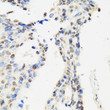| Tissue Specificity | Expressed in gastric carcinoma tissue and the expression gradually increases with the progression of the carcinoma (at protein level). Expressed ubiquitously in normal tissues. Expressed in 84 to 100% of neoplastic breast, lung, and colon tissues. |
| Post Translational Modifications | ATM/ATR-mediated phosphorylation at Thr-454 upon DNA damage promotes binding to SIRT1. Phosphorylation at Thr-454 promotes its sumoylation by switching the binding partner of CCAR2 from SENP1 to PIAS3. Acetylation at Lys-112 and Lys-215 by KAT8 prevents inhibitory binding to SIRT1 and increases its deacetylase activity. Genotoxic stress induces its sumoylation and sumoylation promotes the SIRT1-CCAR2 interaction which in turn inhibits SIRT1-mediated deacetylation of p53/TP53. Sumoylation leads to transcriptional activation of p53/TP53 by sequestering SIRT1 from p53/TP53. Desumoylated by SENP1. |
| Function | Core component of the DBIRD complex, a multiprotein complex that acts at the interface between core mRNP particles and RNA polymerase II (RNAPII) and integrates transcript elongation with the regulation of alternative splicing: the DBIRD complex affects local transcript elongation rates and alternative splicing of a large set of exons embedded in (A + T)-rich DNA regions. Inhibits SIRT1 deacetylase activity leading to increasing levels of p53/TP53 acetylation and p53-mediated apoptosis. Inhibits SUV39H1 methyltransferase activity. Mediates ligand-dependent transcriptional activation by nuclear hormone receptors. Plays a critical role in maintaining genomic stability and cellular integrity following UV-induced genotoxic stress. Regulates the circadian expression of the core clock components NR1D1 and BMAL1. Enhances the transcriptional repressor activity of NR1D1 through stabilization of NR1D1 protein levels by preventing its ubiquitination and subsequent degradation. Represses the ligand-dependent transcriptional activation function of ESR2. Acts as a regulator of PCK1 expression and gluconeogenesis by a mechanism that involves, at least in part, both NR1D1 and SIRT1. Negatively regulates the deacetylase activity of HDAC3 and can alter its subcellular localization. Positively regulates the beta-catenin pathway (canonical Wnt signaling pathway) and is required for MCC-mediated repression of the beta-catenin pathway. Represses ligand-dependent transcriptional activation function of NR1H2 and NR1H3 and inhibits the interaction of SIRT1 with NR1H3. Plays an important role in tumor suppression through p53/TP53 regulation.stabilizes p53/TP53 by affecting its interaction with ubiquitin ligase MDM2. Represses the transcriptional activator activity of BRCA1. Inhibits SIRT1 in a CHEK2 and PSEM3-dependent manner and inhibits the activity of CHEK2 in vitro. |
| Protein Name | Cell Cycle And Apoptosis Regulator Protein 2Cell Division Cycle And Apoptosis Regulator Protein 2Dbird Complex Subunit Kiaa1967Deleted In Breast Cancer Gene 1 ProteinDbc-1Dbc.1Net35P30 Dbc |
| Database Links | Reactome: R-HSA-3371453 |
| Cellular Localisation | NucleusCytoplasmCytoskeletonSpindleRecruited To ChromatinPost-Uv IrradiationSequestered To The Cytoplasm In The Presence Of MccTranslocated To The Cytoplasm During Uv-Induced Apoptosis |
| Alternative Antibody Names | Anti-Cell Cycle And Apoptosis Regulator Protein 2 antibodyAnti-Cell Division Cycle And Apoptosis Regulator Protein 2 antibodyAnti-Dbird Complex Subunit Kiaa1967 antibodyAnti-Deleted In Breast Cancer Gene 1 Protein antibodyAnti-Dbc-1 antibodyAnti-Dbc.1 antibodyAnti-Net35 antibodyAnti-P30 Dbc antibodyAnti-CCAR2 antibodyAnti-DBC1 antibodyAnti-KIAA1967 antibody |
Information sourced from Uniprot.org












